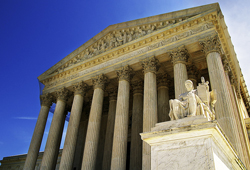 As we previously reported, in Janssen v. Celltrion, Janssen appealed the district court’s partial final judgment that Janssen’s ’471 patent, relating to monoclonal antibodies including infliximab, is invalid.
As we previously reported, in Janssen v. Celltrion, Janssen appealed the district court’s partial final judgment that Janssen’s ’471 patent, relating to monoclonal antibodies including infliximab, is invalid.
As we also previously reported, Janssen filed its opening appeal brief on January 26, 2017. On March 7, 2017, Celltrion filed its response brief. On April 20, 2017, Janssen filed its reply brief.
In its reply, Janssen argued that the district court erred in granting summary judgment that claims of the pre-URAA ’471 patent are invalid for obviousness-type double patenting (OTDP) in view of the post-URAA ’444 patent. Specifically, Janssen argued that the Act of Congress that decided that pre-URAA patents that descend from the same priority application as post-URAA patents should have a “greater” statutory term overrode the general principle that once patent protection expires the public generally should be free to use what had been patented.
Janssen also argued that the district court erred in granting summary judgment that the claims of the ’471 patent are invalid for OTDP in view of the ’195 and ’272 patents, because it erred in rejecting the applicability of the statutory safe harbor, and in rejecting the applicability of the “two-way” test for double patenting. Specifically, Janssen first argued that the district court improperly adopted a new “bright line rule” that the statutory safe harbor can never apply to any patent that is not labeled as a divisional at the time of its original filing. Janssen then argued that the PTO was solely responsible for the ’471 patent issuing after the ’272 and ’195 patents, and so a “two-way” test for double patenting should apply, that analyzes whether claims of the ’471 patent are invalid for OTDP over the claims of the ’272 and ’195 patents, and vice versa. Moreover, Janssen argued that even the two-way test analysis that the district court did provide was flawed in that it used the specification of the ’471 patent in its analysis of the invalidity of the ’272 and ’195 patents, rather than comparing the claims of the ’272 and ’195 patents to the claims of the ’471 patent alone.
In the related CAFC appeal of the ex parte reexamination ruling by the USPTO that the ’471 patent’s claims are unpatentable for double patenting, the appellee’s brief is due on May 9, 2017.
